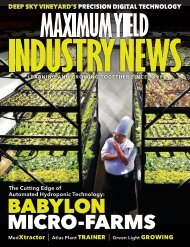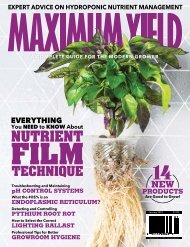Maximum Yield Canada July/August 2017
While hydroponics is unlikely to overtake traditional agriculture economically anytime soon—current US annual crop production is estimated at $143 billion while hydroponics is valued at a mere $600 million—it’s not so much as how much is being grown but where. Today, nobody knows what society will be like in 2100. We hope it will be a peaceful, healthy, and happy place.
While hydroponics is unlikely to overtake traditional agriculture economically anytime soon—current US annual crop production is estimated at $143 billion while hydroponics is valued at a mere $600 million—it’s not so much as how much is being grown but where. Today, nobody knows what society will be like in 2100. We hope it will be a peaceful, healthy, and happy place.
Create successful ePaper yourself
Turn your PDF publications into a flip-book with our unique Google optimized e-Paper software.
plant analysis<br />
“WHILE HYDROPONICS<br />
may seem like the ideal<br />
tool to provide the optimal<br />
level of each element in<br />
a well-balanced nutrient<br />
solution, in reality, nutrition<br />
is much more complex.”<br />
Top: Researchers often use plant analysis to determine optimal nutritional<br />
programs for new crops at different stages of growth. Bottom: Using<br />
plant analysis of a well-grown soil crop can be used to formulate nutrient<br />
solutions for new crops, such as these hydroponic peanuts.<br />
of the element shown to be low or deficient in the nutrient<br />
solution will not improve the problem. Other factors need<br />
to be addressed. Calcium is a common example of this, and<br />
iron is another. Calcium-related disorders such as blossom<br />
end rot and tip burn in lettuce and many other plants are a<br />
result of a lack of calcium incorporated into new developing<br />
tissue. However, in hydroponics, where calcium is typically<br />
supplied in most nutrient products at fairly high levels, a<br />
lack of calcium in the root zone is hardly ever the cause of<br />
the deficiency symptoms. In this case, low foliar calcium<br />
levels on a plant analysis report are often a direct result<br />
of growing conditions, which have limited plant uptake of<br />
calcium from the hydroponics solution. These conditions<br />
include high humidity, warm temperatures, and lack of air<br />
flow. All of these restrict transpiration from the foliage, in<br />
turn restricting calcium uptake and transportation within<br />
the transpirational flow inside the plant. Increasing calcium<br />
levels in the nutrient solution to address these low foliar<br />
calcium levels (when levels are not actually deficient) will<br />
not assist with induced mineral deficiencies.<br />
Nutrient interactions can also induce nutrient deficiencies<br />
in the foliar analysis tests despite there being no actual lack<br />
of a particular element in the nutrient solution. An example<br />
of this is in the use of high levels of ammonium, which also<br />
restricts calcium uptake in the root zone. This can induce<br />
calcium deficiency in the foliage and fruit of the plant that<br />
subsequently shows up on the foliar analysis reports.<br />
Under certain growing conditions, such as sub-optimal<br />
temperatures, certain plants are unable to take up iron<br />
or phosphorus efficiently and may show low foliar levels,<br />
despite these elements being present in the nutrient<br />
solution at good levels. If the plant roots have been<br />
suffering from a root rot pathogen or root die-back, foliar<br />
mineral analysis may show multiple deficiencies in many<br />
nutrients; however, this is simply due to the root system<br />
being unable to take up sufficient minerals from the<br />
nutrient solution due to tissue damage. A lack of oxygen<br />
in the root zone can also induce mineral deficiency. This<br />
is also due to damaged roots being unable to take up the<br />
nutrients required for healthy foliar levels.<br />
To avoid these types of issues, it is usually beneficial to<br />
carry out both nutrient solution and foliar mineral level<br />
testing, particularly in recirculating systems where certain<br />
nutrients may become depleted rapidly. This data can then<br />
be used to determine if there is an ongoing problem with<br />
the formulation, lack of any one essential element in the<br />
nutrient solution causing low foliar levels, or another issue<br />
effecting uptake and distribution within the plant.<br />
Where the nutrient product or formulation is found to be the<br />
cause of low, deficient, and even toxic levels of any element<br />
as shown up in a plant analysis report, this data can then<br />
be used to adjust levels in the nutrient solution. Increasing<br />
deficient levels of most elements in the nutrient solution will<br />
rapidly lead to higher levels of uptake and incorporation<br />
into new leaf tissue. For some elements, particularly the<br />
micro or trace elements, foliar sprays can also assist to<br />
help quickly overcome a deficiency issue. A follow-up<br />
leaf analysis can then be used to confirm the deficiency or<br />
toxicity problem has been solved.<br />
Plant analysis is likely to become an increasingly important<br />
aspect of indoor hydroponic production as growers come<br />
to understand more of the complexities of crop nutrition,<br />
boosting growth, and maximizing yields. While hydroponics<br />
may seem like the ideal tool to provide the optimal level of<br />
each element in a well-balanced nutrient solution, in reality,<br />
nutrition is much more complex, and a little monitoring<br />
and plant analysis can go a long way to reaching the full<br />
potential of the system.<br />
38 feature

















